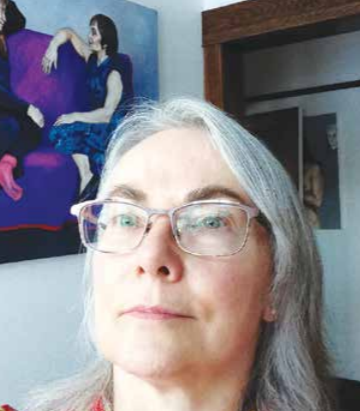
Creative types all over the world have been talking about their muses going missing during the COVID pandemic.
Iris Hauser is not among them.
Since the lockdown began last March, the Saskatoon painter and art teacher produced 33 canvases by December, not including several more previously begun. These are not small landscapes, still lifes or little sketches. These are large, thematic, complex works.
Hauser normally paints 12 to 15 canvases annually, while also teaching in the University of Saskatchewan Extension Division’s Certificate of Art and Design program. When her mother-in-law died, and then the pandemic shut down her classes, Hauser dove full-time into her studio.
She was surprised to realize how much time she had spent caring for her mother-in-law and absorbed in her classes.
“(Teaching) was my main source of income, but when you teach, you’re always thinking about the students; your focus is split. I had not realized how much of my energy went into that,” she said in an interview. “So, all of a sudden I have nothing but time and I’ve just been prolific.”

been prolific in the pandemic
Born in Cranbrook, B.C., Hauser studied at the Nova Scotia College of Art and Design and then the University of Saskatchewan. She moved to Kessel, Germany, to study for a year before returning to Canada.
Her work has been shown regularly over the past decades. One of her more recent shows, Dress Codes, explored the individual sexuality of women partly through their garments. The show’s tour began at the Art Gallery of Regina.
Among her recent works are two series: abstracts inspired by the artist Rothko, and a colourful study series of women all seated in various poses.
“They’re complex,” she said. “They require development of the thought. They’re also layered; there are multiple layers of painting. It’s not like you paint it once and you’re done. I do an underpainting, I do a rough in, and then I repaint to get the details of things and glazing at the end. There are layers of paint to get that glowing surface that I want, the luminosity in the skin. There’s a lot of work in each one.”
Another artistic path she is following combines various historical inspirations into her own works.
“A significant one is a nude from the back with three black circles (on the ground). That one is the genesis of this whole concept of playing with space using art historical references, almost like musicians take little cuts from this and that and make new music out of it.”
The painting, Violon D’Ingres and The Void, depicts a crouched woman with violin holes in her back appearing as if she will spring from one of the black circles to the next. Hauser has taken a work by Jean Ingres, a French artist; a photograph by Man Ray, who added the holes to Ingres’ original work; and a sculpture by Anish Kapour (The Void), melding them together in a different way. Le Violon d’Ingres is a French idiom that means “hobby.”
“The woman in the Man Ray photograph was his mistress. When he put the violin holes on her back, it was like saying ‘this is my hobby.’ It’s patriarchal. I wanted her to have the sense of agency of going somewhere,” Hauser said.
“It’s taking all these influences and putting them all together and making them my own, making the abstract and the real work together — which is kind of a trick, in a way.
“I’ve also really been exploring colour. For example . . . there’s a whole series of my yoga instructor that’s all the colours of the rainbow . . . and integrating the figure with these very abstract grounds.”
Hauser has heard some of her students say, as so many other artists have, that it has been hard for them to work during the pandemic. One of them “gets her inspiration from the world” and has felt obstructed during lockdown.
“She observes the world; she sees little gestures, things that interest and intrigue her. Things she would paint would be (for example) they’d go to a wedding and see the bride in the beautiful fantasy dress with a beer bottle in her hand. That kind of image appeals to her. And she can’t do that now.”
Hauser, however, finds her inspirations come from the inside.
“I’m always thinking about things. It could be something I read in a book or see in a show. It could come from any source. I’m always curious about the why of things. My paintings come from my thinking, rather than what I see. I’m constantly going inside to get my paintings; when I have fewer outside distractions, it’s easier to access that, to explore concepts and ideas.
“I am pretty passionate about it. It’s my way of understanding life and the world.”
That includes her personal life: for example, she painted a series about her brother’s battle with bipolar disorder and depression.
“I’ve always processed what I’m going through in that way,” she said.
“I’m not staggered by life because I deal with it through my paintings.”
She has, as so many others, also done her share of binge-watching TV during the pandemic.
“We’ve finally indulged in Netflix. My favourite show (Lucifer) I thought had just gone and died, and no; it was on Netflix now.”
Shows of her work are planned for Art Placement and, in concert with her husband, cabinetmaker and blacksmith Zach Houser, at the Craft Council Gallery next year. You can see Hauser’s work at http://www. irishauser.ca/.
-Joanne Paulson

Leave a Reply